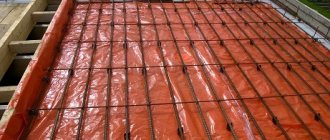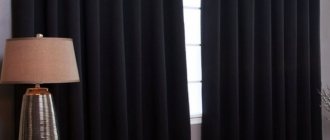Historical reference
The presence of a Russian stove has become a real legend - previously such heating structures were installed in every private house. They have become an integral part of Russian folklore. Even today it is difficult to find a replacement for a Russian stove, taking into account its reliability!
It is not known exactly when they began installing similar structures for heating homes in Russia. According to approximate data, their prototypes appeared 4 thousand years ago, when people decided to equip their house with the ability to make a fire hidden under clay materials.
Stove in a rural wooden house
In Rus', stoves were distinguished by the peculiarity of their masonry. Until the 13th century, the most common variants were chimneys, in which there were no chimney pipes facing the street. In such options, smoke escaped from the premises due to drafts through the door, but at the same time, soot constantly settled on any surfaces, which caused a lot of inconvenience.
However, the usual version appeared only in the 18th century. Then they were made of bricks with fire-resistant properties, they had chimneys. At that time, such structures were placed exclusively in the corners of huts, not far from the front door. It was permissible to leave a small space between the wall and the stove, where various kitchen utensils were stored.
Russian stoves and modern interiors
A large number of folk beliefs are associated with the Russian stove, but then the 20th century came - all this became a thing of the past. The development of technological progress has made its own adjustments to the installation of autonomous heating in any private homes. People most often began to equip city houses with gas or electric heating. However, the classic type Russian stove is economical and easy to use, which is why today the fashion for installing it is returning in country houses.
Small stove in the living room decorated with tiles
Modern options are no longer used for direct cooking, since it is important to use electric and gas burners. However, this is still an effective way to organize autonomous heating of a house, as well as a decorative element of a modern interior, and quite an original one at that.
Types of outdoor Russian stoves. Design diagram
When choosing your project, think about what functions the structure should perform: fry, steam, cook, smoke. In accordance with this, make your choice of an outdoor Russian stove:
- with barbecue;
- with barbecue;
- with space for a cauldron;
- only with hob;
- with smokehouse;
- with a bed.
The stove design can be either the simplest or the most complex; it can include elements traditional for a Russian stove:
- a place for drying firewood - an oven;
- a place for storing dishes and other utensils - a stove;
- a place for hot pots removed from the oven - a hearth;
- the chamber under the pole is the overpipe;
- the surface in the cooking chamber where the cooking utensils are placed - under;
- the chamber itself is a crucible;
- covering the chimney to preserve heat - a view;
- a window leading to the chimney - a choke;
- draft regulator - damper.
Photo 1. Diagram of the structure of an ordinary Russian wood-burning stove, all the main structural elements are indicated.
A design with a couch is also possible, but in the outdoor version it is not very appropriate or serves other purposes.
Important! The diagram and drawings of the furnace should include everything you plan to build
An ordinary Russian stove for the street
The simplest outdoor stove consists of a frame, a one- or two-burner stove, and a tunnel firebox, which is divided into flame and smoke chambers by a smoke tooth. The scheme of such masonry is relatively simple and does not require special knowledge or the use of technology. It is suitable for outdoor use because:
- thanks to the smoke tooth there is no dependence on the strength and direction of the wind;
- cooking becomes possible at any temperature;
- You can cook even with the lowest quality fuel.
The cooking surface can vary from one to two square meters. m or more - depending on the chosen scheme. The height of the crucible according to the standard version can be 70 cm.
The Russian-style mini-oven measures 100 cm by 130 cm. But it is multifunctional and allows you to cook any dishes, bake bread and has a number of advantages:
- low-cost financially;
- convenient and easy to use;
- quickly built;
- prepares dishes quickly;
- does not require a large amount of fuel;
- environmentally friendly
You can build an outdoor mini-oven in one day.
Advice.
Do not start building a mini-oven if there is no drawing, project, or developed design. Get qualified advice from specialists.
Outdoor device with barbecue
The structure of a self-made barbecue includes a tray with fuel and a grate with meat at a height of 10-15 cm.
The hot air after heating the stove will act as an open flame. Food is cooked not over an open fire, but inside a crucible. The firebox can be located either away from the inserted grills for cooking meat or under them. Different stove designs with barbecue imply different construction options. When choosing a project, focus on your culinary preferences.
Note! Meat cooked in a Russian street oven has more beneficial properties. In the oven, cooking takes place in a niche fenced off with partitions.
Thanks to less draft and the absence of wind and temperature changes, the meat is cooked in its own juices
In the oven, cooking takes place in a niche fenced off with partitions. Thanks to less draft and the absence of wind and temperature changes, the meat is cooked in its own juices.
Russian stove in a gazebo under a canopy
Such a project involves the development of a specific design, which should harmoniously fit into the overall interior of the site and fit well with the architecture of the house.
When choosing a design for such an outdoor Russian stove, you immediately think through the gazebo in which the new structure will be located. The project must comply with:
- the size of the area allocated for construction;
- fireproof materials from which it is planned to construct both the gazebo and the stove;
- other characteristics of the gazebo, allowing you to place a structure with a firebox and flame under its arches.
The gazebo should be spacious and beautiful. If desired, it can be designed with closing windows or rollable blinds.
Important! Before building a gazebo, check out all the interesting and modern projects
Varieties of options
During the existence of the Russian stove, quite a lot of variants of its design appeared, which differ from each other in some design features. The first most obvious design element that immediately catches your eye is the type of bed - they come in different sizes or shapes:
- with transverse beds located behind the mouth with a pipe. This is a typical option, which provides two beds at once;
- with a longitudinal type of bed, when it is located behind the firebox. This makes the bed wider, and also provides additional storage space for various equipment.
Obvious differences may be different options for the inflow device:
- the classic inflow is located on one side;
- a firebox with a fireplace allows you to combine a stove with a fireplace, while the fireplace can be brought into another room.
Selection of a Russian stove today
It is worth considering various options for constructing a Russian stove in order to choose the most suitable device. They differ in size and functionality, so it’s worth taking a closer look at each option.
"Alya-rus"
The “ala-rus” option was created, rather, for design purposes, since it collects many classic household items and decorations that are usually associated with Russia and the history of the Russian village. However, there are a number of features:
- do not overload the structure with decorative elements or designs;
- for decoration you can use a balalaika or bunches of dried berries and herbs;
- There will definitely be a place on the walls for embroidered towels or amulets.
Such a stove will be a bright, noticeable spot that will never go unnoticed. For those who are close to traditional Russian superstitions, handmade figurines of brownies would be an excellent decoration option.
Russian hut
In a Russian hut, the classic interior is usually decorated from wooden materials. A classic stove made of brick or clay, finished with decorative materials, fits perfectly into the room. It has a number of features:
- You can use tiles for decoration, but it is unacceptable to use excessively bright shades;
- It is preferable to use blue, white and blue tones of decoration, inclusions of golden shades are acceptable;
- Old Russian classic patterns are used for decoration, which harmonize perfectly with wooden finishing materials.
This design does not necessarily have to be functional. It can only be used as a decorative element, decorating the room, giving it a cozy appearance.
Russian tower
The rich decoration of the Russian tower is most reminiscent of typical illustrations for old Russian fairy tales. A stove made in this style is a very bright and unusual spot in a modern interior, and it will go well with both classic wood and any modern materials. This type of oven has some characteristic features:
- it is permissible to decorate with a large number of tiles, giving a fabulous look to the design;
- the dimensions in this case are usually quite impressive, so it is worth choosing this option for large areas and rooms with massive large windows;
- When decorating, bright and unusual shades are used, and colorful tiles do not interfere with design ideas at all in this case.
If this option is not planned to use the heating function, then it is possible to make a decorative semblance of a stove against the wall from wooden materials, and the design can be complemented by an electric fireplace. In this case, the stove becomes exclusively a decoration, giving the interior motifs of a rustic Russian style.
Making an outdoor Russian stove with your own hands
After you have decided on the design of an outdoor Russian stove, found a place and purchased materials, tools and everything that is necessary for construction, you can begin building the foundation. When the base for the stove is ready, begin laying - strictly in accordance with the diagrams and drawings. First, the bricks are laid on a dry surface - without mortar. This will help determine the correctness of the structure and take into account all the nuances before the final construction of the furnace.
Important! Using horizontal and vertical levels and plumb lines when laying dry, check the correctness of the laid out orders. If the dry masonry corresponds to all the diagrams and drawings, then prepare the solution and begin making row masonry, not missing the necessary holes for the chimney and other technological spaces corresponding to the diagram
If the dry masonry corresponds to all the diagrams and drawings, then prepare the solution and begin making row masonry, not missing the necessary holes for the chimney and other technological spaces that correspond to the diagram.
Preparing the site at the dacha
The place should be sufficient in area and preferably level. If necessary, the area should be leveled using a shovel and rake.
For the stove, it is better to choose the most comfortable place for you:
- from the sunny side;
- at a distance from wooden buildings and fences;
- no shading of plantings on the site;
- preferably in a gazebo.
It is advisable to build a stove together with a gazebo, in the same color scheme, from homogeneous materials. It is advisable to reflect this in the diagram and project.
How to make a foundation
After choosing a location on your property, begin building the foundation. Its main criteria should be:
- evenness;
- smoothness;
- a certain area;
- reliability;
- durability.
For the foundation:
- dig a hole corresponding to the pattern of width and length to a depth of 30-50 cm;
- pour sand - make a sand cushion 20 cm;
- pour crushed stone on top to ground level;
- choose a base - a monolithic concrete slab of the appropriate size or do-it-yourself concreting;
- for concreting, we put up formwork, install reinforcement, and fill it with mortar.
If the stove is built in a finished wooden gazebo, all fire safety rules must be observed. To do this, basalt cardboard or asbestos cardboard and a sheet of roofing iron, a clay layer and again a layer of basalt cardboard are laid on the boards. Laying begins after the mortar has dried.
Important! Avoid distortions or unexpected voids in the masonry. This will lead to deformation of the entire structure
Furnace order
We carry out dry laying of the furnace project. If everything is lined up correctly, taking into account the sizes, shapes and components, you can begin building a furnace with mortar.
In accordance with the photos, diagrams and drawings, they begin laying the furnace in order. A typical project involves 13-20 rows.
Photo 3. Layout diagram of an ordinary small Russian stove with a hob, without additional elements.
From the second to the third row, we do the masonry taking into account the space for fuel: coal and firewood. Then we take into account the chimney and ash pit. On the back wall of the furnace, approximately on the eighth row, we mount brackets and pins for grates and grids for barbecuing or installing a barbecue (according to the project). You can make more brackets to rearrange the racks depending on the heat of the oven and the method of cooking.
Important! When laying, it is necessary to remove all excess mortar with a trowel. Under no circumstances should clay solution be applied to the inner surface; this will impair thermal conductivity and lead to increased soot deposition on the walls.
When laying in rows, do not forget the holes for the view, choke, and damper. We mount according to the dimensions of the door.
Where to install
In country houses, modern homeowners are increasingly returning the Russian stove to their interiors, since neither kitchen appliances nor various heaters can actually replace the live fire and heat from a real stove. But when the question arises about the location of the stove, there are a lot of nuances that should be taken into account when planning the installation of a Russian stove.
Installation in the living room
In this option, the stove becomes the central element of the interior of the room. That is why very bright and beautiful stove design options are most often chosen for the living room, and the stove itself is installed at a fairly large distance from the furniture elements of the room.
Living rooms made in a rustic style are very popular today, which are quite inexpensive and at the same time look very impressive. To create such interiors, mostly wooden and metal materials are used, and the furniture does not have any frills or overly elaborate details.
It is worth remembering some nuances:
- furniture is selected with pastel colors in the design, as well as without unnecessary decorative elements, so that they do not distract attention from the main element - the Russian stove;
- lighting must be selected unobtrusively, using discreet lamps or stylized kerosene lamps;
- On top of the stove you can equip a bed with handmade blankets and soft pillows embroidered with Russian patterns.
For modern furniture and interiors decorated without wooden materials, stoves with a strict design, without unnecessary decorative elements, in a minimalist style are perfect. It is acceptable to finish the stove with artificial decorative stone or finishing brick, and expensive furniture options, including upholstered furniture with leather upholstery, are in perfect harmony with such options.
Installation in the kitchen
The kitchen is a classic place to install a Russian stove. It must be said that this is the best place, but there are some nuances here, since modern cuisine is significantly different from the ancient Russian cuisine of classic wooden houses. When installing, keep the following points in mind:
- It is unacceptable to install household appliances near the stove - they should all be at a fairly impressive distance;
- the dining part of the room should not be in close proximity to the stove so that it does not get too hot;
- You should not overload the outer sides of the Russian stove with decorations and various small decorative elements.
For a rustic kitchen, a minimalist style using wooden materials will be relevant. It is better to leave suspended ceilings and wallpaper for city apartments - their surfaces quickly become unusable due to high temperatures, and it is better to leave wooden finishing materials or paints and varnishes.
It is important for the kitchen to remain bright and cozy, so large windows are made in the room, and appropriate lighting fixtures are installed. The bright design of the Russian stove in the kitchen using noticeable stains and paints for a design accent will be relevant.
Modern Russian stoves: the return of tradition
It cannot be said that Russian stoves are an unusual item in the interior of a home. In many Russian regions (in particular, in villages, towns, villages) there is no central heating and, accordingly, heating a stove remains the only way to heat a living space.
However, more and more homeowners are installing stoves in their homes, not because of the lack of other ways to maintain a comfortable temperature in the house. The reasons for this are often:
- the desire to create coziness in the house and gather with the family in the evenings in front of a pleasantly crackling fireplace;
- desire to cook original Russian dishes.
Photos of modern Russian stoves prove that the stove will not look like an alien even in the most fashionable interior. A huge number of different finishing materials make it possible to make even the simplest stove a source of pride for the owners of the house, without in any way detracting from its functionality. Today, stoves are built in a variety of sizes and placed in the most convenient place in the house (not necessarily in the kitchen, especially if you don’t plan to cook in it). Quite often, the room where the brazier is supposed to be located is decorated in a rustic style, which has already become a trend, as in the photo:
Very willingly stoves are placed:
- in the living room;
- in the kitchen;
- in the dining room;
- in the hall;
- in the office;
- in the library room;
- between rooms.
Modern housewives find it a pleasure to cook in a real Russian stove - specially sinks, hoods, dishwashers and other amenities of civilization into the stove complex
Large rooms are often “divided” by a stove, giving it enough space. This placement of a Russian stove not only looks aesthetically pleasing, but also has a practical basis - the heat transfer from the stove walls is much higher.
Russian stoves also fit perfectly into a summer kitchen, in which case it will be possible to use this room not only in the summer, but throughout the rest of the year. If installing it indoors is not possible, you can place it in an outdoor gazebo, equipped like a barbecue. This way the functionality of the fryer will be even greater.
Furnace decoration
Today, different materials are used to decorate a Russian stove. They are selected depending on whether the stove is new or an old stove needs repair, as well as how the room looks. In the case of an old stove, work is first carried out to prepare the surfaces, including eliminating cracks and removing old plaster, as well as dismantling old structures in order to replace them with new ones.
Once all surfaces are in working order, they can be decorated using a variety of modern or classic materials, as well as various design styles depending on the overall style in which the house is decorated.
Tiles
Traditional decorations for Russian stoves are tiles. They give the product a colorful and incredibly beautiful appearance, and are also reliable and of high quality, and are made from refractory types of clay. They are attached to the oven wall using a gun, and their front part is covered with glaze and ornamentation to achieve maximum decorative effect.
Among the features of such decorative materials are:
- tiles are permissible only when decorating options with brickwork;
- the cladding is laid from bottom to top, constantly wetting the tiles with water;
- For grouting joints, gypsum dough with a special composition is used.
There are a huge number of tile patterns, and for their implementation, both relief and flat tiles with different color designs are used. Tiles can be plain or painted, and can also be made in several colors. The colors of the tiles should be selected taking into account the general style of the premises of the private house where the Russian stove is installed.
Plaster and paint
A budget option for facing materials would be decorative plaster or modern types of decorative paint. This is the cheapest option, but no less beautiful. A relevant option for modern interiors in a minimalist style that do not have unnecessary decorative elements.
Among the features of this finish we can highlight:
- the need to heat the stove and wet the walls with water before starting work;
- the plaster is applied in at least two layers, and the second should be thicker;
- After plastering, a layer of paint or decorative plaster is applied.
In this case, any color of the materials for cladding is possible, and should be selected exclusively in accordance with the design style of the premises of a private house. If you need to visually reduce the size of the structure a little, then you should choose darker paint options for the corresponding effect, so that the stove is darker than other furnishings in the rooms.
Decorative tiles
The tile is a very original and beautiful design option. Such finishing materials can be secured with adhesive mortar and nails to hold the edges of the tiles. Among very unusual materials, you can select natural stone, such as marble or granite, but this is quite expensive.
Features of tiled decoration are:
- the need to select heat-resistant tiles that will not burst due to temperature;
- the importance of choosing a high-quality, durable solution for fixing materials.
Visually, such materials have a cold effect, and therefore are more suitable for wide living rooms or kitchens. For small living rooms, it is better to choose other finishing options in order to achieve a warmer visual effect for the Russian stove.
Household decoration
Replacing the cladding is a rather costly and serious issue that will require a lot of effort and money. However, if the stove is old and the flaws are not too noticeable, then you can get by with decorating it with various household elements. Disadvantages can be hidden using a variety of things:
- towels embroidered with traditional patterns;
- old style pottery and cast iron pots;
- bunches of dried berries or herbal mixtures;
- wood stands and woodpile near the stove;
- pillows, skins and blankets on the bed.
In addition, you can place various shelves for pots, dishes and other kitchen utensils, which will not only decorate the walls, but also make them functional.
Results
Regardless of interior styles, the Russian stove has found its use, if not in a classic form, then in various variations. The latter can successfully cope with both practical and aesthetic functions. And even in the modern design of a country house, there may be a place for an element of Russian culture, which was often used by our ancestors to prevent various diseases.
Everyone can find their own version of decorating a country house using a Russian stove. However, you should not lay the stove yourself, even to save money. It is best to order the manufacture of a stove from a master who has completed several orders and can do everything with high quality. Then such a stove will be absolutely safe and will be able to perform all its assigned functions.
Features of the Russian stove
When installing a Russian stove, you will first need to make sure that the foundation of the building can withstand the extra hundreds of kilograms. Strong foundations are suitable, for the creation of which brick or concrete is chosen. With a pile foundation, additional strengthening is required, and in this case it is better to abandon either the idea of installing a Russian stove or this type of foundation.
At the bottom of the structure there is a base with an equipped chamber, which is usually used to store various additional functional elements, as well as fuel for lighting a Russian stove. The base allows you to raise the stove for more comfortable operation.
A vault is installed on top of the base, on which additional sand or clay is poured, and the bottom of the firebox is installed on it. At the same time, they specially make a slight slope towards the wall, so that it is convenient to use the firebox of a Russian stove and work with fuel. In addition, this is how the fuel will burn evenly.
The firebox consists of a cooking chamber and a crucible, and in front there is an opening with metal flaps for storing fuel, as well as installing utensils with prepared dishes. If you do not plan to use this stove for cooking, then you should abandon this design element.
Decorative rock
Stone is rarely used for lining a Russian stove; it does not really match the appearance of the structure. Most often, stone is used to decorate the portal or base of the stove, but it can also be used for the entire body.
Materials and tools
For finishing you need:
- facing stone (you can use hewn and wild stone, pebbles);
- adhesive solution (clay or cement);
- level;
- comb;
- rubber hammer;
- solution container;
- metal grid;
- mesh fasteners;
- construction mixer.
The optimal solution for stone is clay in a ratio of 1:2 (clay and sifted sand, respectively). For large-format stones, it is better to take a cement mortar with a component ratio of 1:2:1 (cement, fatty clay, sand, respectively).
Instructions
Scheme
- Before cladding begins, the surface is reinforced with a metal mesh, which is attached to the seams of the brickwork. Next, the mesh is covered with a layer of plaster mortar (as for conventional plastering of a stove). The surface must dry, after which it should be leveled and sanded.
- The cladding begins from the bottom row, the glue is applied with a comb to the surface of the stove and the tiles, then each element is pressed tightly against the wall. Using a rubber hammer, carefully tap the stone to give it the desired position. When laying, it is not recommended to make very wide seams, as the surface will not look very beautiful.
If necessary, individual stone plates are trimmed with a grinder; this should be done as the finishing is being glued. All excess solution is removed immediately, since after drying it will be almost impossible to remove it.











